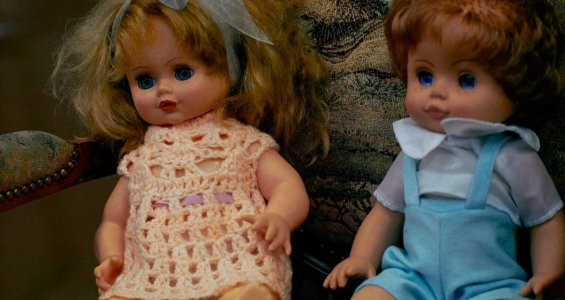Moms are standing by their dolls—and critics can’t stop talking
- Replies 1
They’re not what they seem at first glance.
A stroll through a park or a quick look in a stroller might reveal something so realistic, it causes a double-take.
But for a growing group of people, these lifelike baby dolls offer something far deeper than shock value.
Whether it’s healing, companionship, or just plain joy, this trend is turning heads—and drawing lines in the sand.
Reborn dolls are hand-crafted figures that look and feel like real babies. They’re carefully painted, filled for weight, and finished with fine details like eyelashes, wrinkles, and rooted hair.
Some are so realistic, passersby have mistaken them for real infants—and in some rare cases, even rushed them to emergency rooms. The movement has especially gained momentum in one South American country, where enthusiasts are building tight-knit communities.
Online, videos of people role-playing with these dolls have drawn massive attention. Simulated “births,” first baths, and outings have been viewed by millions—sparking both celebration and backlash.
Lawmakers in certain regions have even debated whether public health systems should ever be involved in treating them. One politician appeared in a legislative session holding a reborn doll, calling for restrictions on their use in medical facilities.

But health officials stated clearly that no official cases involving reborn dolls had ever been recorded. Despite political showdowns, the demand—and passion—for these dolls hasn’t slowed. Collectors say they’re more than just props. Many turn to the dolls for emotional healing, often after personal loss or during empty nest stages of life.
Berenice Maria, a longtime collector and nursing assistant, said plainly: “I love reborns, despite the hate we see out there. I want the right to go out with them … go to the mall, go to the park.”
Dozens of “reborn mothers” recently met in a popular park for their 10th annual gathering, showing off their dolls and enjoying a shared sense of belonging.
They say criticism should be directed at influencers looking for clicks—not at everyday collectors who find peace in the hobby.
Daniela Baccan, who runs a doll shop with her partner, said their dolls range from around $124 to nearly $1,800.
Prices vary based on realism and detail. With rising attention has come rising tension—especially at her store.
Also read: A new survey breaks down the real cost of joy—and which hobbies hurt your wallet most
“We’re locking up the store more, adding cameras,” she said. “But at the same time, online demand has increased, and the store is seeing a much higher flow of people.”
Some collectors use their reborns to practice parenting skills. Others say the dolls give them comfort, especially during emotionally challenging periods.
The dolls are also increasingly being used in elder care. Staff report that holding them can reduce agitation and loneliness among seniors facing memory decline. Even with the growing acceptance, controversy continues.
Some observers argue that treating the dolls like real babies in public is “bizarre.”
In legislative chambers, proposals have been introduced to penalize those who might attempt to access health services for their dolls—though none of those efforts have produced any formal cases.
Congresswoman Talíria Petrone criticized her colleagues for putting energy into the issue at all.
“Can we focus on what really matters?” she asked. “If someone wants to have a doll, let them. I have two real children and they’re more than enough work.”
Supporters say the issue is about autonomy and empathy. They believe no one should be mocked or punished for finding comfort in a form others may not understand.
Also read: Get the Le Creuset look for less: This Hobby Lobby bakeware set is turning heads!
Collectors also emphasize that the dolls don’t replace real relationships. They simply provide a different kind of support—one that, for many, is deeply therapeutic. Online and in-person communities have become places of encouragement and relief.
They offer advice, share new designs, and provide friendship to those often left isolated by grief or judgment. The artistry behind the dolls is also part of the appeal. Each creation can take dozens of hours, requiring advanced painting skills, hair rooting, and body assembly.
Some artists have gained loyal followings for their craftsmanship alone. And with demand continuing to rise, the business of reborns shows no signs of fading.
Whether you find them fascinating, confusing, or touching, these dolls have started a conversation that’s not going away. They’ve become tools of healing, objects of debate, and symbols of both comfort and controversy.
And for many who cradle them—not just in their arms but in their hearts—they’re nothing short of meaningful.
Read next: From trash to treasure: How a glam mom turned dumpster diving into a $30K goldmine

Have you ever seen a reborn doll in public? Do you know someone who owns one—or have one yourself? Does this trend seem heartwarming, unusual, or something else entirely? We want to hear your story in the comments below.
A stroll through a park or a quick look in a stroller might reveal something so realistic, it causes a double-take.
But for a growing group of people, these lifelike baby dolls offer something far deeper than shock value.
Whether it’s healing, companionship, or just plain joy, this trend is turning heads—and drawing lines in the sand.
Reborn dolls are hand-crafted figures that look and feel like real babies. They’re carefully painted, filled for weight, and finished with fine details like eyelashes, wrinkles, and rooted hair.
Some are so realistic, passersby have mistaken them for real infants—and in some rare cases, even rushed them to emergency rooms. The movement has especially gained momentum in one South American country, where enthusiasts are building tight-knit communities.
Online, videos of people role-playing with these dolls have drawn massive attention. Simulated “births,” first baths, and outings have been viewed by millions—sparking both celebration and backlash.
Lawmakers in certain regions have even debated whether public health systems should ever be involved in treating them. One politician appeared in a legislative session holding a reborn doll, calling for restrictions on their use in medical facilities.

Reborn dolls are hand-crafted figures that look and feel like real babies. Image Source: Dana Sarsenbekova / Unsplash
But health officials stated clearly that no official cases involving reborn dolls had ever been recorded. Despite political showdowns, the demand—and passion—for these dolls hasn’t slowed. Collectors say they’re more than just props. Many turn to the dolls for emotional healing, often after personal loss or during empty nest stages of life.
Berenice Maria, a longtime collector and nursing assistant, said plainly: “I love reborns, despite the hate we see out there. I want the right to go out with them … go to the mall, go to the park.”
Dozens of “reborn mothers” recently met in a popular park for their 10th annual gathering, showing off their dolls and enjoying a shared sense of belonging.
They say criticism should be directed at influencers looking for clicks—not at everyday collectors who find peace in the hobby.
Daniela Baccan, who runs a doll shop with her partner, said their dolls range from around $124 to nearly $1,800.
Prices vary based on realism and detail. With rising attention has come rising tension—especially at her store.
Also read: A new survey breaks down the real cost of joy—and which hobbies hurt your wallet most
“We’re locking up the store more, adding cameras,” she said. “But at the same time, online demand has increased, and the store is seeing a much higher flow of people.”
Some collectors use their reborns to practice parenting skills. Others say the dolls give them comfort, especially during emotionally challenging periods.
The dolls are also increasingly being used in elder care. Staff report that holding them can reduce agitation and loneliness among seniors facing memory decline. Even with the growing acceptance, controversy continues.
Some observers argue that treating the dolls like real babies in public is “bizarre.”
In legislative chambers, proposals have been introduced to penalize those who might attempt to access health services for their dolls—though none of those efforts have produced any formal cases.
Congresswoman Talíria Petrone criticized her colleagues for putting energy into the issue at all.
“Can we focus on what really matters?” she asked. “If someone wants to have a doll, let them. I have two real children and they’re more than enough work.”
Supporters say the issue is about autonomy and empathy. They believe no one should be mocked or punished for finding comfort in a form others may not understand.
Also read: Get the Le Creuset look for less: This Hobby Lobby bakeware set is turning heads!
Collectors also emphasize that the dolls don’t replace real relationships. They simply provide a different kind of support—one that, for many, is deeply therapeutic. Online and in-person communities have become places of encouragement and relief.
They offer advice, share new designs, and provide friendship to those often left isolated by grief or judgment. The artistry behind the dolls is also part of the appeal. Each creation can take dozens of hours, requiring advanced painting skills, hair rooting, and body assembly.
Some artists have gained loyal followings for their craftsmanship alone. And with demand continuing to rise, the business of reborns shows no signs of fading.
Whether you find them fascinating, confusing, or touching, these dolls have started a conversation that’s not going away. They’ve become tools of healing, objects of debate, and symbols of both comfort and controversy.
And for many who cradle them—not just in their arms but in their hearts—they’re nothing short of meaningful.
Read next: From trash to treasure: How a glam mom turned dumpster diving into a $30K goldmine
Key Takeaways
- A growing number of people are turning to ultra-realistic reborn dolls for emotional comfort, parenting practice, and therapeutic care.
- Controversy has grown online and in political spaces, with lawmakers in one country debating public health involvement.
- Dolls can cost between $124 and $1,800, and one shop owner noted increased demand and tighter security due to public attention.
- Supporters say the dolls offer emotional relief, while critics argue the public treatment of dolls as real babies is “bizarre.”






